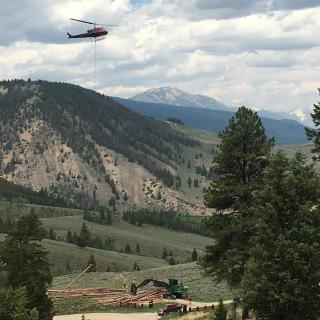In the summer of 2019, Forest Service entomologist Amy Lockner made her way along the Taylor Canyon Road toward Gunnison, Colorado, a small mountain town situated in a valley often referred to as the “Gateway to the Rockies.”
As she drove down the winding canyon road flanked by pine trees, her gaze caught a subtle inconsistency in the forest canopy that other travelers would not have noticed. What caught Lockner’s eye was a group of lodgepole pines beginning to fade and discolor.
The sudden realization hit her like a thunderclap. Years of experience studying insect species and their effect on the environment trained her to look out for the tell-tale signs of mountain pine beetles. She took note of the spot, turned off the main road, and immediately looked for a nearby landowner to get permission to collect samples.
“I knew that given the size and age class of the lodgepole pine on the hillside, it had to be mountain pine beetle,” said Lockner. “This is the same species that had killed so many millions of acres in Colorado several years before, and I was overwhelmed. I knew I needed to act fast, especially if we had any chance of slowing it down.”
Mountain pine beetles burrow into pine trees to lay eggs. Once the eggs hatch, the offspring feed on the living tree from the inside. Over just a few weeks, the larvae destroy the tree’s vital systems. After several months, the tree turns red and brown as it dies. The cycle takes just one year, and the newly formed beetle is off to find their next host and begin it all again.
As the population of beetles grows from an outbreak to an epidemic, they spread across tens of thousands of trees and cause mass death. Giant swaths of dead trees throughout the mountain west show the aftermath of epidemics dating back to the early 2000s.
The knock-on effects of these epidemics continue today. Dead and dry trees have caused more severe wildfires, and the standing dead trees pose a serious hazard to hikers and to motorists alike.
Lockner likely changed the course of history for one of the last large forests of lodgepole pine in the intermountain west when she noted the infestation. Her quick thinking set off a coordinated intragovernmental response to save 290,000 acres of contiguous lodgepole pine on the Gunnison National Forest and the surrounding landscape.

Today, the Forest Service, the Colorado State Forest Service, the National Forest Foundation, local landowners, and Gunnison county communities are in a race against the clock to stem the tide and keep the beetle outbreak from becoming an epidemic.
Time is of the essence.
“One thing we learned from similar outbreaks is that we do not have a lot of time to talk about the issue,” said Matt McCombs, district ranger for the Forest Service’s Gunnison Ranger District. “In order to get a handle on a mountain pine beetle outbreak, we have to act quickly, and we have to coordinate across all lands.”
The partners have established a 2,200-acre project area to survey and treat for beetle hotspots. They have treated 260 acres, contracting with local logging operators to remove infected trees before the larvae mature and take flight. They have also removed dead, dying, and at-risk trees from outbreak areas and turned them into usable timber, ensuring that nothing goes to waste.
While the speed at which land managers have acted has made the early stages of this response successful, the relationships between the partners have made both the speed and the scale possible.
“The Colorado Forest Service and the Forest Service have been working together for a long time. We have built strong relationships over the years, and partners like the National Forest Foundation are helping us to elevate our collaboration to a whole new level,” said Sam Pankratz, supervisory forester for the Colorado State Forest Service. “When we come together, we leave our logos at the door and work towards the common goal.”

Coloradans and most Western communities know firsthand the destruction of mountain pine beetles. Local landowners in Gunnison and the surrounding communities are working with federal and state land managers to address the outbreak across all lands.
“The Wilder-Highlands project is the very definition of shared stewardship,” said Joe Lavorini, the National Forest Foundation’s stewardship coordinator for Gunnison County. “Every partner is indispensable to the success of this response. There is still a lot of work to be done on this particular outbreak, but we are setting a standard for how to work together. The model can be replicated in other forest health projects around the country.”
To learn more about how the Forest Service works across boundaries to carry out its multiple-use mission, see the Shared Stewardship website. For more information on the Wilder-Highlands Mountain Pine Beetle Response Project, visit the National Forest Foundation website.





